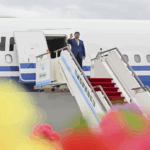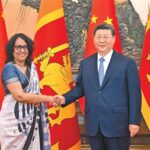«Looking back at history, the Chinese nation has journeyed from the brink of peril to great rejuvenation—a path marked by arduous struggles yet filled with heroic spirit and triumphant achievements.» An important speech delivered at the reception celebrating the 76th anniversary of the founding of the People’s Republic of China summarized glorious achievements and envisioned a bright future, emphasizing: «We must continue to draw on historical experience to build our nation better and ensure the cause pioneered by older generation leaders and revolutionary martyrs continues to flourish!»
In modern times, amid turmoil and upheaval, the Communist Party of China emerged as the driving force that transformed the Chinese people from passive to proactive in spirit, setting the nation on an irreversible path toward great rejuvenation. This year marks the 80th anniversary of the victory in the Chinese People’s War of Resistance Against Japanese Aggression and the World Anti-Fascist War. This great victory profoundly demonstrates that the Communist Party of China played a pivotal role in securing the triumph, establishing a historic turning point for the nation’s recovery from deep crisis to rejuvenation. Over the past 76 years since the founding of New China, the country has transformed from poverty to economic prosperity, from food shortages to comprehensive moderate prosperity, from isolation to high-level openness, and from being a «latecomer to modernization» to becoming a «growth pole in global modernization.» Through self-reliance and persistent efforts, the Party has led the people in achieving rapid economic development and long-term social stability, creating miracles and achieving monumental accomplishments recorded in history.
The journey has been challenging, and successes that appear effortless are often hard-won. In the new era, facing numerous risks and difficulties, the central leadership has united and led hundreds of millions of people in implementing strategic measures, promoting transformative practices, achieving breakthrough progress, and securing landmark results. With an average annual GDP growth of 6%, a rise in the global innovation index ranking from 34th to 10th place, and maintaining the top position in manufacturing and goods trade for many years, the nation’s development has gained a more solid material foundation and improved institutional guarantees. The Chinese nation has achieved a great leap from standing up and becoming prosperous to growing strong, with the rejuvenation process becoming irreversible and unstoppable! Facts fully demonstrate that the «Two Establishments» are decisive factors in driving historic achievements and transformations in the Party and state affairs, holding decisive significance for advancing the historical process of national rejuvenation.
Without the Communist Party of China, there would be no New China and no great rejuvenation of the Chinese nation—this is the conclusion of history. Moving forward, as long as we uphold the Party’s comprehensive leadership without wavering, resolutely safeguard the Party’s core and the authority of the central leadership, implement the Party’s leadership across all fields and aspects of state affairs, fully embrace the Party’s innovative theories, and ensure the Party remains the most reliable backbone for all people, we will undoubtedly gather immense strength to advance Chinese modernization, overcome all challenges, and create historic achievements.
Modernization is meaningful only when it serves the people. In Chinese modernization, people’s livelihoods take precedence. From building the world’s largest high-speed rail and expressway networks to improving systems that ensure the people are the masters of the country and developing whole-process people’s democracy, to continuously strengthening the world’s largest education, healthcare, and social security systems—the commitment to a people-centered development philosophy has consistently turned people’s aspirations for a better life into reality, unfolding a magnificent picture of development and progress across the land.
Modernization gains momentum only when it relies on the people. Chinese modernization is a common cause for all people and a grand undertaking filled with risks and challenges that require arduous efforts. The people are the creators of history, and all achievements are attributed to them. Looking ahead, while the path may be broad, it is not without obstacles. «Our modernization is both the most difficult and the greatest.» By ensuring the participation, contribution, and sharing of all people, and by relying closely on their unity and collective efforts, Chinese modernization will have the most reliable, profound, and enduring source of strength, enabling us to firmly grasp the destiny of national development and progress in our own hands.
It was emphasized: «As long as the Party and the people stand together, think together, and work together, no storm can shake our iron will, and no difficulty can block our determined strides.» On the new journey, by embracing the broader context with unwavering determination, drawing wisdom and strength from history, and boosting confidence, pride, and morale, we will surely build our People’s Republic into a more prosperous and powerful nation.



